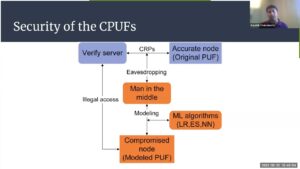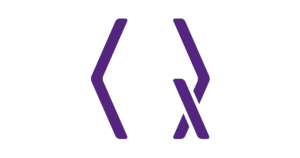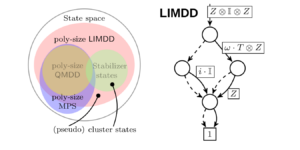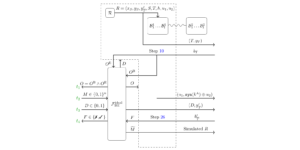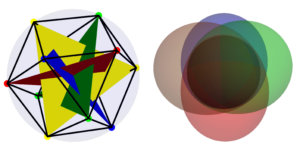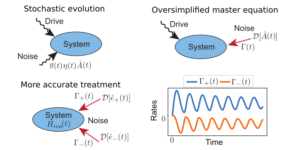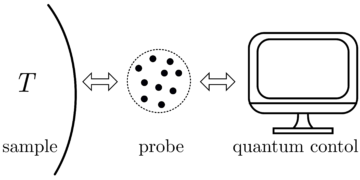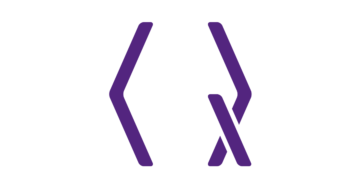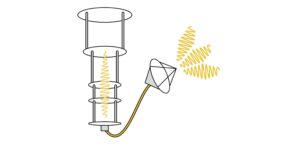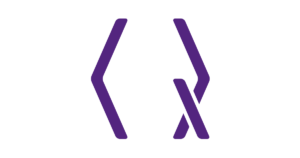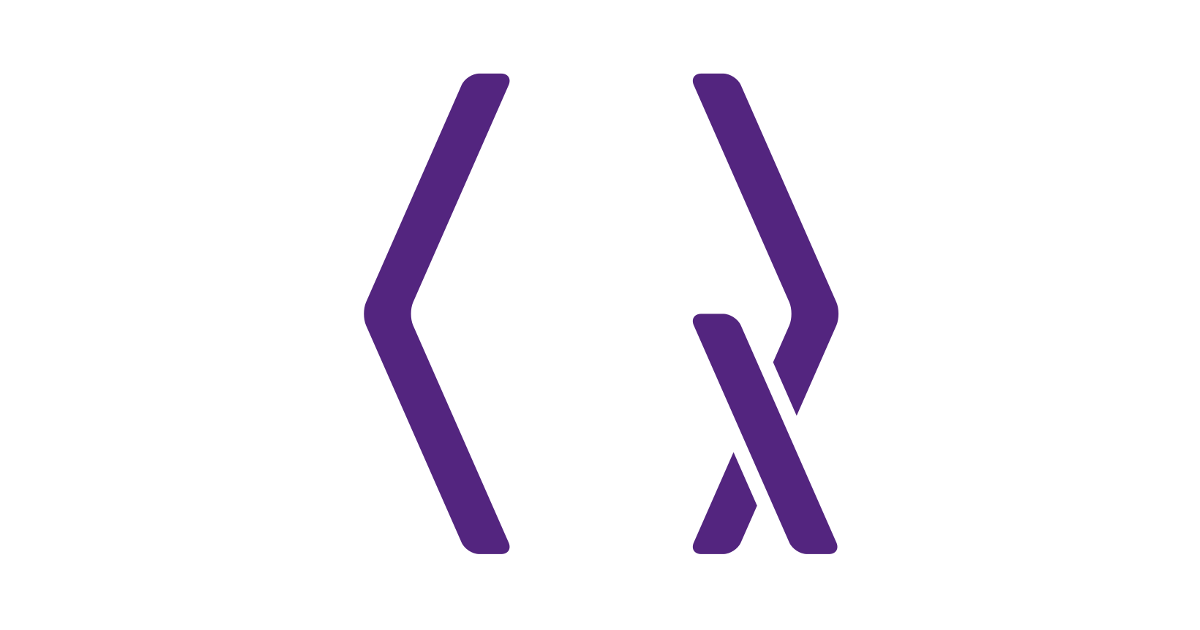
1Department of Physics, University of Waterloo, Waterloo, ON, N2L 3G1, Canada
2Institute for Quantum Computing, Waterloo, ON, N2L 3G1, Canada
3Perimeter Institute for Theoretical Physics, Waterloo, Ontario, N2L 2Y5, Canada
4Xanadu, Toronto, ON, M5G 2C8, Kanada
Érdekesnek találja ezt a cikket, vagy szeretne megvitatni? Scite vagy hagyjon megjegyzést a SciRate-en.
Absztrakt
The widespread success of deep neural networks has revealed a surprise in classical machine learning: very complex models often generalize well while simultaneously overfitting training data. This phenomenon of benign overfitting has been studied for a variety of classical models with the goal of better understanding the mechanisms behind deep learning. Characterizing the phenomenon in the context of quantum machine learning might similarly improve our understanding of the relationship between overfitting, overparameterization, and generalization. In this work, we provide a characterization of benign overfitting in quantum models. To do this, we derive the behavior of a classical interpolating Fourier features models for regression on noisy signals, and show how a class of quantum models exhibits analogous features, thereby linking the structure of quantum circuits (such as data-encoding and state preparation operations) to overparameterization and overfitting in quantum models. We intuitively explain these features according to the ability of the quantum model to interpolate noisy data with locally “spiky” behavior and provide a concrete demonstration example of benign overfitting.
► BibTeX adatok
► Referenciák
[1] Michael A Nielsen. “Neural networks and deep learning”. Determination Press. (2015). url: http://neuralnetworksanddeeplearning.com/.
http://neuralnetworksanddeeplearning.com/
[2] Stuart Geman, Elie Bienenstock, and René Doursat. “Neural networks and the bias/variance dilemma”. Neural Comput. 4, 1–58 (1992).
https:///doi.org/10.1162/neco.1992.4.1.1
[3] Trevor Hastie, Robert Tibshirani, Jerome H Friedman, and Jerome H Friedman. “The elements of statistical learning: data mining, inference, and prediction”. Volume 2. Springer. (2009).
https://doi.org/10.1007/978-0-387-84858-7
[4] Peter L. Bartlett, Andrea Montanari, and Alexander Rakhlin. “Deep learning: a statistical viewpoint”. Acta Numerica 30, 87–201 (2021).
https:///doi.org/10.1017/S0962492921000027
[5] Mikhail Belkin. “Fit without fear: remarkable mathematical phenomena of deep learning through the prism of interpolation”. Acta Numerica 30, 203–248 (2021).
[6] Peter L. Bartlett, Philip M. Long, Gábor Lugosi, and Alexander Tsigler. “Benign overfitting in linear regression”. Proc. Natl. Acad. Sci. 117, 30063–30070 (2020).
https:///doi.org/10.1073/pnas.1907378117
[7] Mikhail Belkin, Daniel Hsu, Siyuan Ma, and Soumik Mandal. “Reconciling modern machine-learning practice and the classical bias-variance trade-off”. Proc. Natl. Acad. Sci. 116, 15849–15854 (2019).
https:///doi.org/10.1073/pnas.1903070116
[8] Mikhail Belkin, Alexander Rakhlin, and Alexandre B. Tsybakov. “Does data interpolation contradict statistical optimality?”. In Proceedings of Machine Learning Research. Volume 89, pages 1611–1619. PMLR (2019). url: https://proceedings.mlr.press/v89/belkin19a.html.
https://proceedings.mlr.press/v89/belkin19a.html
[9] Vidya Muthukumar, Kailas Vodrahalli, Vignesh Subramanian, and Anant Sahai. “Harmless interpolation of noisy data in regression”. IEEE Journal on Selected Areas in Information Theory 1, 67–83 (2020).
https:///doi.org/10.1109/ISIT.2019.8849614
[10] Vidya Muthukumar, Adhyyan Narang, Vignesh Subramanian, Mikhail Belkin, Daniel Hsu, and Anant Sahai. “Classification vs regression in overparameterized regimes: Does the loss function matter?”. J. Mach. Learn. Res. 22, 1–69 (2021). url: http://jmlr.org/papers/v22/20-603.html.
http:///jmlr.org/papers/v22/20-603.html
[11] Yehuda Dar, Vidya Muthukumar, and Richard G. Baraniuk. “A farewell to the bias-variance tradeoff? an overview of the theory of overparameterized machine learning” (2021). arXiv:2109.02355.
arXiv: 2109.02355
[12] Marcello Benedetti, Erika Lloyd, Stefan Sack, and Mattia Fiorentini. “Parameterized quantum circuits as machine learning models”. Quantum Sci. Technol. 4, 043001 (2019).
https://doi.org/10.1088/2058-9565/ab4eb5
[13] K. Mitarai, M. Negoro, M. Kitagawa és K. Fujii. „Kvantumkör tanulás”. Phys. Rev. A 98, 032309 (2018).
https:///doi.org/10.1103/physreva.98.032309
[14] Maria Schuld, Ville Bergholm, Christian Gogolin, Josh Izaac és Nathan Killoran. „Analitikai gradiensek kiértékelése kvantumhardveren”. Phys. Rev. A 99, 032331 (2019).
https:///doi.org/10.1103/physreva.99.032331
[15] Maria Schuld és Nathan Killoran. „Kvantumgépi tanulás jellemző Hilbert-terekben”. Phys. Rev. Lett. 122, 040504 (2019).
https:///doi.org/10.1103/physrevlett.122.040504
[16] Vojtěch Havlíček, Antonio D. Córcoles, Kristan Temme, Aram W. Harrow, Abhinav Kandala, Jerry M. Chow és Jay M. Gambetta. „Felügyelt tanulás kvantum-bővített jellemzőterekkel”. Nature 567, 209–212 (2019).
https://doi.org/10.1038/s41586-019-0980-2
[17] Seth Lloyd and Christian Weedbrook. “Quantum generative adversarial learning”. Phys. Rev. Lett. 121, 040502 (2018).
https:///doi.org/10.1103/physrevlett.121.040502
[18] Pierre-Luc Dallaire-Demers and Nathan Killoran. “Quantum generative adversarial networks”. Phys. Rev. A 98, 012324 (2018).
https:///doi.org/10.1103/physreva.98.012324
[19] Amira Abbas, David Sutter, Christa Zoufal, Aurelien Lucchi, Alessio Figalli, and Stefan Woerner. “The power of quantum neural networks”. Nat. Comput. Sci. 1, 403–409 (2021).
https://doi.org/10.1038/s43588-021-00084-1
[20] Logan G. Wright and Peter L. McMahon. “The capacity of quantum neural networks”. In 2020 Conference on Lasers and Electro-Optics (CLEO). Pages 1–2. (2020). url: https://ieeexplore.ieee.org/document/9193529.
https:///ieeexplore.ieee.org/document/9193529
[21] Sukin Sim, Peter D. Johnson, and Alán Aspuru-Guzik. “Expressibility and entangling capability of parameterized quantum circuits for hybrid quantum-classical algorithms”. Adv. Quantum Technol. 2, 1900070 (2019).
https:///doi.org/10.1002/qute.201900070
[22] Thomas Hubregtsen, Josef Pichlmeier, Patrick Stecher, and Koen Bertels. “Evaluation of parameterized quantum circuits: on the relation between classification accuracy, expressibility and entangling capability”. Quantum Mach. Intell. 3, 1 (2021).
https:///doi.org/10.1007/s42484-021-00038-w
[23] Jarrod R McClean, Sergio Boixo, Vadim N Smelyanskiy, Ryan Babbush és Hartmut Neven. „Kivár fennsíkok kvantum-neurális hálózatok képzési tájain”. Nat. Commun. 9, 4812 (2018).
https://doi.org/10.1038/s41467-018-07090-4
[24] Marco Cerezo, Akira Sone, Tyler Volkoff, Lukasz Cincio, and Patrick J Coles. “Cost function dependent barren plateaus in shallow parametrized quantum circuits”. Nat. Commun. 12, 1791 (2021).
https:///doi.org/10.1038/s41467-021-21728-w
[25] Matthias C. Caro, Elies Gil-Fuster, Johannes Jakob Meyer, Jens Eisert, and Ryan Sweke. “Encoding-dependent generalization bounds for parametrized quantum circuits”. Quantum 5, 582 (2021).
https://doi.org/10.22331/q-2021-11-17-582
[26] Hsin-Yuan Huang, Michael Broughton, Masoud Mohseni, Ryan Babbush, Sergio Boixo, Hartmut Neven, and Jarrod R McClean. “Power of data in quantum machine learning”. Nat. Commun. 12, 2631 (2021).
https://doi.org/10.1038/s41467-021-22539-9
[27] Matthias C. Caro, Hsin-Yuan Huang, M. Cerezo, Kunal Sharma, Andrew Sornborger, Lukasz Cincio, and Patrick J. Coles. “Generalization in quantum machine learning from few training data”. Nat. Commun. 13, 4919 (2022).
https://doi.org/10.1038/s41467-022-32550-3
[28] Leonardo Banchi, Jason Pereira, and Stefano Pirandola. “Generalization in quantum machine learning: A quantum information standpoint”. PRX Quantum 2, 040321 (2021).
https:///doi.org/10.1103/PRXQuantum.2.040321
[29] Francisco Javier Gil Vidal and Dirk Oliver Theis. “Input redundancy for parameterized quantum circuits”. Front. Phys. 8, 297 (2020).
https:///doi.org/10.3389/fphy.2020.00297
[30] Maria Schuld, Ryan Sweke és Johannes Jakob Meyer. „Az adatkódolás hatása a variációs kvantum-gépi tanulási modellek kifejező erejére”. Phys. Rev. A 103, 032430 (2021).
https:///doi.org/10.1103/physreva.103.032430
[31] David Wierichs, Josh Izaac, Cody Wang és Cedric Yen-Yu Lin. „Általános paramétereltolási szabályok kvantumgradiensekhez”. Quantum 6, 677 (2022).
https://doi.org/10.22331/q-2022-03-30-677
[32] Kendall E Atkinson. “An introduction to numerical analysis”. John Wiley & Sons. (2008).
[33] Ali Rahimi and Benjamin Recht. “Random features for large-scale kernel machines”. In Advances in Neural Information Processing Systems. Volume 20. (2007). url: https://papers.nips.cc/paper_files/paper/2007/hash/013a006f03dbc5392effeb8f18fda755-Abstract.html.
https://papers.nips.cc/paper_files/paper/2007/hash/013a006f03dbc5392effeb8f18fda755-Abstract.html
[34] Walter Rudin. “The basic theorems of fourier analysis”. John Wiley & Sons, Ltd. (1990).
https:///doi.org/10.1002/9781118165621.ch1
[35] Song Mei and Andrea Montanari. “The generalization error of random features regression: Precise asymptotics and the double descent curve”. Commun. Pure Appl. Math. 75, 667–766 (2022).
https:///doi.org/10.1002/cpa.22008
[36] Trevor Hastie, Andrea Montanari, Saharon Rosset, and Ryan J. Tibshirani. “Surprises in high-dimensional ridgeless least squares interpolation”. Ann. Stat. 50, 949 – 986 (2022).
https:///doi.org/10.1214/21-AOS2133
[37] Tengyuan Liang, Alexander Rakhlin, and Xiyu Zhai. “On the multiple descent of minimum-norm interpolants and restricted lower isometry of kernels”. In Proceedings of Machine Learning Research. Volume 125, pages 1–29. PMLR (2020). url: http://proceedings.mlr.press/v125/liang20a.html.
http://proceedings.mlr.press/v125/liang20a.html
[38] Edward Farhi és Hartmut Neven. „Osztályozás kvantumneurális hálózatokkal rövid távú processzorokon” (2018). arXiv:1802.06002.
arXiv: 1802.06002
[39] Maria Schuld, Alex Bocharov, Krysta M. Svore és Nathan Wiebe. „Árkörközpontú kvantumosztályozók”. Phys. Rev. A 101, 032308 (2020).
https:///doi.org/10.1103/physreva.101.032308
[40] Adrián Pérez-Salinas, Alba Cervera-Lierta, Elies Gil-Fuster, and José I. Latorre. “Data re-uploading for a universal quantum classifier”. Quantum 4, 226 (2020).
https://doi.org/10.22331/q-2020-02-06-226
[41] Sofiene Jerbi, Lukas J Fiderer, Hendrik Poulsen Nautrup, Jonas M Kübler, Hans J Briegel, and Vedran Dunjko. “Quantum machine learning beyond kernel methods”. Nat. Commun. 14, 517 (2023).
https:///doi.org/10.1038/s41467-023-36159-y
[42] Casper Gyurik, Dyon Vreumingen, van, and Vedran Dunjko. “Structural risk minimization for quantum linear classifiers”. Quantum 7, 893 (2023).
https://doi.org/10.22331/q-2023-01-13-893
[43] Mária Schuld. „A felügyelt kvantumgépi tanulási modellek kernel módszerek” (2021). arXiv:2101.11020.
arXiv: 2101.11020
[44] S. Shin, Y. S. Teo, and H. Jeong. “Exponential data encoding for quantum supervised learning”. Phys. Rev. A 107, 012422 (2023).
https:///doi.org/10.1103/PhysRevA.107.012422
[45] Sophie Piccard. “Sur les ensembles de distances des ensembles de points d’un espace euclidien.”. Memoires de l’Universite de Neuchatel. Secretariat de l’Universite. (1939).
[46] Dave Wecker, Matthew B. Hastings, Nathan Wiebe, Bryan K. Clark, Chetan Nayak, and Matthias Troyer. “Solving strongly correlated electron models on a quantum computer”. Phys. Rev. A 92, 062318 (2015).
https:///doi.org/10.1103/PhysRevA.92.062318
[47] Ian D. Kivlichan, Jarrod McClean, Nathan Wiebe, Craig Gidney, Alán Aspuru-Guzik, Garnet Kin-Lic Chan és Ryan Babbush. „Elektronikus szerkezet kvantumszimulációja lineáris mélységgel és kapcsolódási lehetőséggel”. Phys. Rev. Lett. 120, 110501 (2018).
https:///doi.org/10.1103/PhysRevLett.120.110501
[48] Martín Larocca, Frédéric Sauvage, Faris M. Sbahi, Guillaume Verdon, Patrick J. Coles és M. Cerezo. „Csoportinvariáns kvantumgépi tanulás”. PRX Quantum 3, 030341 (2022).
https:///doi.org/10.1103/PRXQuantum.3.030341
[49] Johannes Jakob Meyer, Marian Mularski, Elies Gil-Fuster, Antonio Anna Mele, Francesco Arzani, Alissa Wilms, and Jens Eisert. “Exploiting symmetry in variational quantum machine learning”. PRX Quantum 4, 010328 (2023).
https:///doi.org/10.1103/PRXQuantum.4.010328
[50] Martin Larocca, Nathan Ju, Diego García-Martín, Patrick J Coles, and Marco Cerezo. “Theory of overparametrization in quantum neural networks”. Nat. Comput. Sci. 3, 542–551 (2023).
https://doi.org/10.1038/s43588-023-00467-6
[51] Yuxuan Du, Min-Hsiu Hsieh, Tongliang Liu, and Dacheng Tao. “Expressive power of parametrized quantum circuits”. Phys. Rev. Res. 2, 033125 (2020).
https:///doi.org/10.1103/physrevresearch.2.033125
[52] Zoë Holmes, Kunal Sharma, M. Cerezo és Patrick J. Coles. „Az ansatz kifejezhetőség összekapcsolása a gradiens nagyságrendekkel és a kopár fennsíkokkal”. PRX Quantum 3, 010313 (2022).
https:///doi.org/10.1103/PRXQuantum.3.010313
[53] Samson Wang, Enrico Fontana, Marco Cerezo, Kunal Sharma, Akira Sone, Lukasz Cincio, and Patrick J Coles. “Noise-induced barren plateaus in variational quantum algorithms”. Nat. Commun. 12, 6961 (2021).
https://doi.org/10.1038/s41467-021-27045-6
[54] Abdulkadir Canatar, Evan Peters, Cengiz Pehlevan, Stefan M. Wild, and Ruslan Shaydulin. “Bandwidth enables generalization in quantum kernel models”. Transactions on Machine Learning Research (2023). url: https://openreview.net/forum?id=A1N2qp4yAq.
https://openreview.net/forum?id=A1N2qp4yAq
[55] Hsin-Yuan Huang, Michael Broughton, Jordan Cotler, Sitan Chen, Jerry Li, Masoud Mohseni, Hartmut Neven, Ryan Babbush, Richard Kueng, John Preskill, and Jarrod R. McClean. “Quantum advantage in learning from experiments”. Science 376, 1182–1186 (2022).
https:///doi.org/10.1126/science.abn7293
[56] Sitan Chen, Jordan Cotler, Hsin-Yuan Huang, and Jerry Li. “Exponential separations between learning with and without quantum memory”. In 2021 IEEE 62nd Annual Symposium on Foundations of Computer Science (FOCS). Pages 574–585. (2022).
https:///doi.org/10.1109/FOCS52979.2021.00063
[57] Hsin-Yuan Huang, Richard Kueng, and John Preskill. “Information-theoretic bounds on quantum advantage in machine learning”. Phys. Rev. Lett. 126, 190505 (2021).
https:///doi.org/10.1103/PhysRevLett.126.190505
[58] Ville Bergholm, Josh Izaac, Maria Schuld, Christian Gogolin, M. Sohaib Alam, Shahnawaz Ahmed, Juan Miguel Arrazola, Carsten Blank, Alain Delgado, Soran Jahangiri, Keri McKiernan, Johannes Jakob Meyer, Zeyue Niu, Antal Száva, and Nathan Killoran. “Pennylane: Automatic differentiation of hybrid quantum-classical computations” (2018). arXiv:1811.04968.
arXiv: 1811.04968
[59] Peter L. Bartlett, Philip M. Long, Gábor Lugosi, and Alexander Tsigler. “Benign overfitting in linear regression”. Proc. Natl. Acad. Sci. 117, 30063–30070 (2020).
https:///doi.org/10.1073/pnas.1907378117
[60] Vladimir Koltchinskii and Karim Lounici. “Concentration inequalities and moment bounds for sample covariance operators”. Bernoulli 23, 110 – 133 (2017).
https://doi.org/10.3150/15-BEJ730
[61] Zbigniew Puchała and Jarosław Adam Miszczak. “Symbolic integration with respect to the haar measure on the unitary group”. Bull. Pol. Acad. Sci. 65, 21–27 (2017).
https:///doi.org/10.1515/bpasts-2017-0003
[62] Daniel A. Roberts and Beni Yoshida. “Chaos and complexity by design”. J. High Energy Phys. 2017, 121 (2017).
https:///doi.org/10.1007/jhep04(2017)121
[63] Wallace C. Babcock. “Intermodulation interference in radio systems frequency of occurrence and control by channel selection”. Bell Syst. tech. j. 32, 63–73 (1953).
https:///doi.org/10.1002/j.1538-7305.1953.tb01422.x
[64] M. Atkinson, N. Santoro, and J. Urrutia. “Integer sets with distinct sums and differences and carrier frequency assignments for nonlinear repeaters”. IEEE Trans. Commun. 34, 614–617 (1986).
https://doi.org/10.1109/TCOM.1986.1096587
[65] J. Robinson and A. Bernstein. “A class of binary recurrent codes with limited error propagation”. IEEE Trans. Inf. 13, 106–113 (1967).
https:///doi.org/10.1109/TIT.1967.1053951
[66] R. J. F. Fang and W. A. Sandrin. “Carrier frequency assignment for nonlinear repeaters”. COMSAT Technical Review 7, 227–245 (1977).
Idézi
[1] Alexey Melnikov, Mohammad Kordzanganeh, Alexander Alodjants, and Ray-Kuang Lee, “Quantum machine learning: from physics to software engineering”, Haladás a fizikában X 8 1, 2165452 (2023).
[2] Mo Kordzanganeh, Pavel Sekatski, Leonid Fedichkin, and Alexey Melnikov, “An exponentially-growing family of universal quantum circuits”, Gépi tanulás: Science and Technology 4 3, 035036 (2023).
[3] Stefano Mangini, “Variational quantum algorithms for machine learning: theory and applications”, arXiv: 2306.09984, (2023).
[4] Ben Jaderberg, Antonio A. Gentile, Youssef Achari Berrada, Elvira Shishenina, and Vincent E. Elfving, “Let Quantum Neural Networks Choose Their Own Frequencies”, arXiv: 2309.03279, (2023).
[5] Yuxuan Du, Yibo Yang, Dacheng Tao, and Min-Hsiu Hsieh, “Problem-Dependent Power of Quantum Neural Networks on Multiclass Classification”, Physical Review Letters 131 14, 140601 (2023).
[6] S. Shin, Y. S. Teo, and H. Jeong, “Exponential data encoding for quantum supervised learning”, Fizikai áttekintés A 107 1, 012422 (2023).
[7] Elies Gil-Fuster, Jens Eisert, and Carlos Bravo-Prieto, “Understanding quantum machine learning also requires rethinking generalization”, arXiv: 2306.13461, (2023).
[8] Jason Iaconis és Sonika Johri, „Tensor Network Based Efficient Quantum Data Loading of Images”, arXiv: 2310.05897, (2023).
[9] Alice Barthe and Adrián Pérez-Salinas, “Gradients and frequency profiles of quantum re-uploading models”, arXiv: 2311.10822, (2023).
[10] Tobias Haug és MS Kim, „Generalization with quantum geometry for learning unitries”, arXiv: 2303.13462, (2023).
[11] Jonas Landman, Slimane Thabet, Constantin Dalyac, Hela Mhiri, and Elham Kashefi, “Classically Approximating Variational Quantum Machine Learning with Random Fourier Features”, arXiv: 2210.13200, (2022).
[12] Berta Casas and Alba Cervera-Lierta, “Multidimensional Fourier series with quantum circuits”, Fizikai áttekintés A 107 6, 062612 (2023).
[13] Elies Gil-Fuster, Jens Eisert, and Vedran Dunjko, “On the expressivity of embedding quantum kernels”, arXiv: 2309.14419, (2023).
[14] Lucas Slattery, Ruslan Shaydulin, Shouvanik Chakrabarti, Marco Pistoia, Sami Khairy, and Stefan M. Wild, “Numerical evidence against advantage with quantum fidelity kernels on classical data”, Fizikai áttekintés A 107 6, 062417 (2023).
[15] Mo Kordzanganeh, Daria Kosichkina, and Alexey Melnikov, “Parallel Hybrid Networks: an interplay between quantum and classical neural networks”, arXiv: 2303.03227, (2023).
[16] Aikaterini, Gratsea, and Patrick Huembeli, “The effect of the processing and measurement operators on the expressive power of quantum models”, arXiv: 2211.03101, (2022).
[17] Shun Okumura and Masayuki Ohzeki, “Fourier coefficient of parameterized quantum circuits and barren plateau problem”, arXiv: 2309.06740, (2023).
[18] Massimiliano Incudini, Michele Grossi, Antonio Mandarino, Sofia Vallecorsa, Alessandra Di Pierro, and David Windridge, “The Quantum Path Kernel: a Generalized Quantum Neural Tangent Kernel for Deep Quantum Machine Learning”, arXiv: 2212.11826, (2022).
[19] Jorja J. Kirk, Matthew D. Jackson, Daniel J. M. King, Philip Intallura, and Mekena Metcalf, “Emergent Order in Classical Data Representations on Ising Spin Models”, arXiv: 2303.01461, (2023).
[20] Francesco Scala, Andrea Ceschini, Massimo Panella, and Dario Gerace, “A General Approach to Dropout in Quantum Neural Networks”, arXiv: 2310.04120, (2023).
[21] Julian Berberich, Daniel Fink, Daniel Pranjić, Christian Tutschku, and Christian Holm, “Training robust and generalizable quantum models”, arXiv: 2311.11871, (2023).
A fenti idézetek innen származnak SAO/NASA HIRDETÉSEK (utolsó sikeres frissítés: 2023-12-21 00:40:54). Előfordulhat, hogy a lista hiányos, mivel nem minden kiadó ad megfelelő és teljes hivatkozási adatokat.
On Crossref által idézett szolgáltatás művekre hivatkozó adat nem található (utolsó próbálkozás 2023-12-21 00:40:53).
Ez a tanulmány a Quantumban jelent meg Creative Commons Nevezd meg 4.0 International (CC BY 4.0) engedély. A szerzői jog az eredeti szerzői jog tulajdonosainál marad, például a szerzőknél vagy intézményeiknél.
- SEO által támogatott tartalom és PR terjesztés. Erősödjön még ma.
- PlatoData.Network Vertical Generative Ai. Erősítse meg magát. Hozzáférés itt.
- PlatoAiStream. Web3 Intelligence. Felerősített tudás. Hozzáférés itt.
- PlatoESG. Carbon, CleanTech, Energia, Környezet, Nap, Hulladékgazdálkodás. Hozzáférés itt.
- PlatoHealth. Biotechnológiai és klinikai vizsgálatok intelligencia. Hozzáférés itt.
- Forrás: https://quantum-journal.org/papers/q-2023-12-20-1210/
- :van
- :is
- :nem
- 1
- 10
- 107
- 11
- 110
- 116
- 12
- 120
- 121
- 125
- 13
- 14
- 15%
- 16
- 17
- 1791
- 19
- 20
- 2008
- 2015
- 2017
- 2018
- 2019
- 2020
- 2021
- 2022
- 2023
- 22
- 23
- 24
- 25
- 26
- 27
- 28
- 29
- 30
- 31
- 32
- 33
- 35%
- 36
- 39
- 40
- 41
- 43
- 46
- 49
- 50
- 51
- 52
- 53
- 54
- 58
- 60
- 65
- 66
- 7
- 75
- 8
- 9
- 98
- a
- Abbas
- képesség
- felett
- KIVONAT
- hozzáférés
- Szerint
- pontosság
- Ádám
- előlegek
- Előny
- ellenséges
- hovatartozás
- ellen
- Ahmed
- alex
- Alexander
- algoritmusok
- alice
- Minden termék
- Is
- an
- elemzés
- Analitikus
- és a
- Andrew
- Anna
- évi
- alkalmazások
- megközelítés
- VANNAK
- területek
- AS
- kísérlet
- szerző
- szerzők
- Automatikus
- b
- meddő
- alapján
- alapvető
- BE
- óta
- viselkedés
- mögött
- Csengő
- am
- Benjámin
- Jobb
- között
- Túl
- üres
- határokat
- szünet
- Bryan
- bika
- by
- képesség
- Kapacitás
- carlos
- Casper
- chan
- csatorna
- chen
- A pop-art design, négy időzóna kijelzése egyszerre és méretének arányai azok az érvek, amelyek a NeXtime Time Zones-t kiváló választássá teszik. Válassza a
- ebéd
- keresztény
- idézi
- osztály
- besorolás
- kódok
- megjegyzés
- köznép
- teljes
- bonyolult
- bonyolultság
- számítások
- számítógép
- Computer Science
- számítástechnika
- beton
- Konferencia
- Connectivity
- kontextus
- ellenőrzés
- copyright
- korrelációs
- Craig
- görbe
- Daniel
- dátum
- adatbányászat
- Dave
- David
- december
- mély
- mély tanulás
- mély idegi hálózatok
- Azt
- függő
- mélység
- származik
- Design
- Ellenére
- meghatározás
- Diego
- különbségek
- megvitatni
- különböző
- do
- nem
- kétszeresére
- e
- Edward
- hatás
- hatékony
- Elektronikus
- elemek
- beágyazás
- lehetővé teszi
- kódolás
- energia
- Mérnöki
- Erika
- hiba
- Eter (ETH)
- bizonyíték
- példa
- kiállítási
- kísérletek
- Magyarázza
- exponenciális
- kifejező
- család
- búcsú
- félelem
- Funkció
- Jellemzők
- kevés
- hűség
- A
- talált
- Alapok
- Francisco
- Frekvencia
- ból ből
- front
- funkció
- általános
- nemző
- generációs versenytárs hálózatok
- geometria
- cél
- színátmenetek
- Csoport
- hardver
- Harvard
- Magas
- tartók
- Hogyan
- HTML
- http
- HTTPS
- huang
- hibrid
- hibrid kvantum-klasszikus
- i
- IEEE
- képek
- javul
- in
- egyenlőtlenségek
- információ
- Intézet
- intézmények
- integráció
- érdekes
- interferencia
- Nemzetközi
- Bevezetés
- Jackson
- JavaScript
- Jerome
- János
- Johnson
- Jordánia
- folyóirat
- juan
- Karim
- Kendall
- Kim
- király
- skót templom
- nagyarányú
- lézerek
- keresztnév
- TANUL
- tanulás
- legkevésbé
- Szabadság
- Lee
- hadd
- li
- Engedély
- Korlátozott
- lin
- Összekapcsolása
- Lista
- betöltés
- helyileg
- Logan
- Hosszú
- le
- alacsonyabb
- Kft.
- gép
- gépi tanulás
- gép
- Marco
- maria
- Márton
- matematikai
- matematikai
- Anyag
- matthew
- Matthias
- Lehet..
- mcclean
- intézkedés
- mérés
- mechanizmusok
- Memory design
- metcalf
- mód
- Meyer
- Michael
- esetleg
- Mikhail
- minimalizálása
- Bányászati
- modell
- modellek
- modern
- pillanat
- Hónap
- többszörös
- Természet
- Közel
- hálózat
- hálózatok
- ideg-
- neurális hálózat
- neurális hálózatok
- nem
- esemény
- of
- gyakran
- oliver
- on
- Ontario
- nyitva
- Művelet
- üzemeltetők
- or
- érdekében
- eredeti
- mi
- áttekintés
- saját
- oldalak
- Papír
- Párhuzamos
- ösvény
- patrick
- kimerül
- jelenség
- Fizika
- Plató
- Platón adatintelligencia
- PlatoData
- pont
- hatalom
- gyakorlat
- pontos
- előrejelzés
- előkészítés
- nyomja meg a
- Probléma
- PROC
- Eljárás
- feldolgozás
- processzorok
- Profilok
- szaporítás
- ad
- közzétett
- kiadó
- kiadók
- Kvantum
- kvantumelőny
- kvantum algoritmusok
- Kvantum számítógép
- kvantumszámítás
- kvantuminformáció
- kvantum gépi tanulás
- R
- rádió
- véletlen
- visszatérő
- referenciák
- rezsimek
- regresszió
- kapcsolat
- kapcsolat
- maradványok
- figyelemre méltó
- megköveteli,
- kutatás
- tisztelet
- korlátozott
- Revealed
- Kritika
- Richard
- Kockázat
- ROBERT
- erős
- szabályok
- Ryan
- s
- Scala
- SCI
- Tudomány
- Tudomány és technológia
- kiválasztott
- kiválasztás
- Series of
- Szettek
- sekély
- Sharma
- előadás
- jelek
- IGEN
- Hasonlóképpen
- tettetés
- egyszerre
- szoftver
- szoftverfejlesztés
- dal
- terek
- Centrifugálás
- terek
- álláspont
- Állami
- statisztikai
- stefan
- erősen
- struktúra
- tanult
- siker
- sikeresen
- ilyen
- megfelelő
- összegek
- felügyelt tanulás
- meglepetés
- Szimpózium
- Systems
- tech
- Műszaki
- Technológia
- kifejezés
- A
- azok
- elméleti
- elmélet
- ezáltal
- Ezek
- ezt
- Keresztül
- Cím
- nak nek
- toronto
- Képzések
- transz
- Tranzakciók
- Trevor
- Tyler
- UN
- alatt
- megértés
- Egyetemes
- egyetemi
- frissítve
- URL
- fajta
- nagyon
- Vincent
- kötet
- vs
- W
- wang
- akar
- volt
- we
- JÓL
- míg
- széles körben elterjedt
- Vadon
- val vel
- nélkül
- Munka
- művek
- Wright
- X
- év
- zephyrnet

